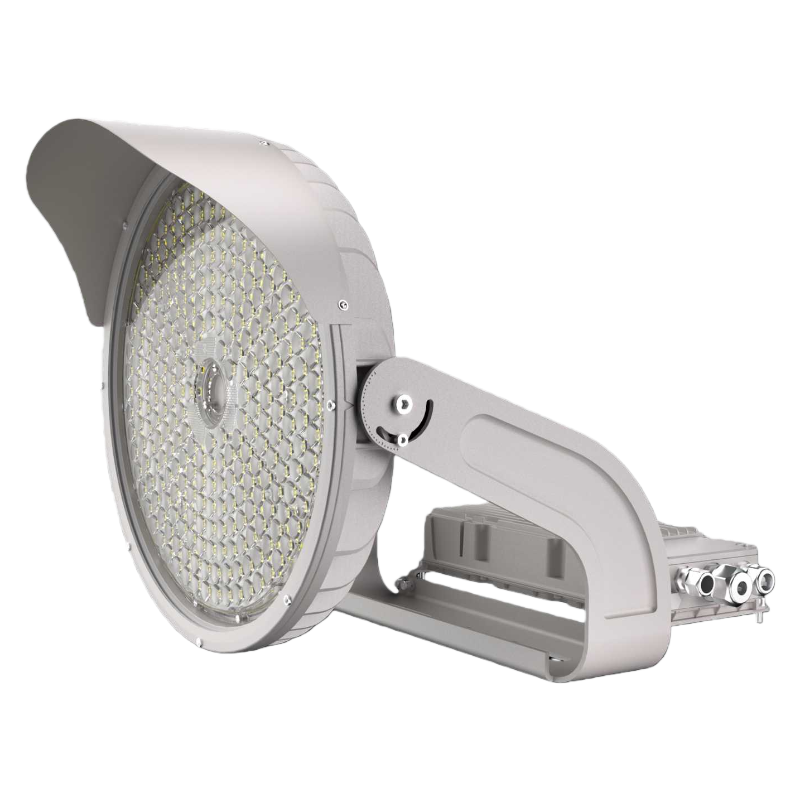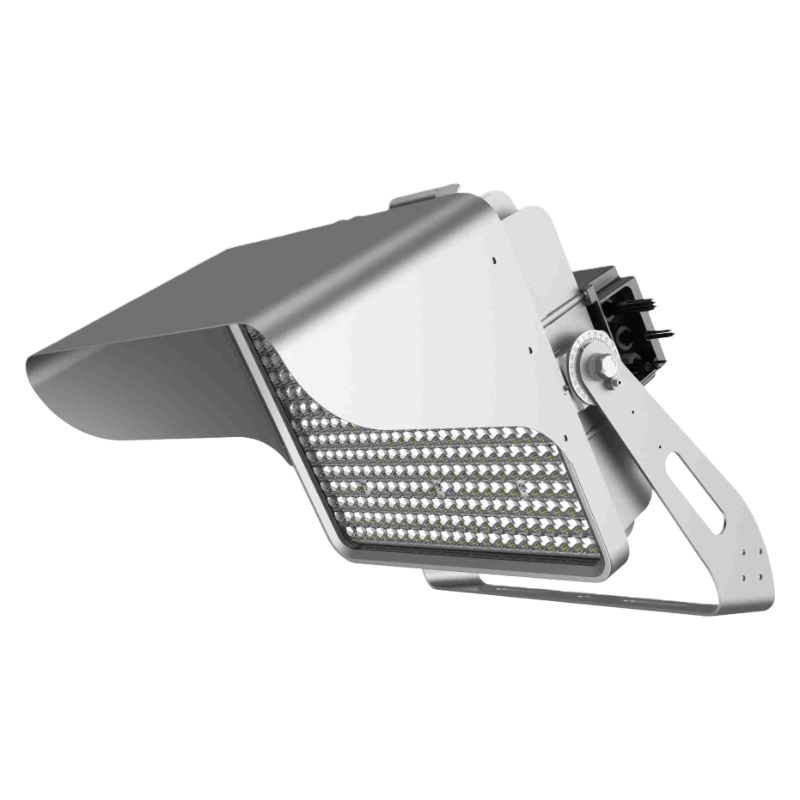What are Outdoor LED Parking Lot Lights?
What are Outdoor LED Parking Lot Lights?
Outdoor LED parking lot lights are specialized lighting fixtures designed to illuminate parking areas, including commercial parking lots, residential complexes, shopping mall parking garages, and public parking spaces. Unlike traditional lighting technologies such as high-pressure sodium (HPS) lamps or metal halide bulbs, these lights utilize light-emitting diodes (LEDs) as their light source. Their primary function is to provide consistent, bright, and uniform illumination across large open areas, ensuring the safety of pedestrians and drivers, deterring criminal activities, and enhancing overall visibility during nighttime or low-light conditions. With advancements in LED technology, modern outdoor LED parking lot lights have evolved to become more energy-efficient, durable, and versatile, making them the preferred lighting solution for both new constructions and retrofitting projects.
Key Advantages of Outdoor LED Parking Lot Lights
Compared to conventional lighting options, outdoor LED parking lot lights offer a multitude of benefits that contribute to their growing popularity in the lighting industry.
1. Exceptional Energy Efficiency
One of the most significant advantages of LED parking lot lights is their high energy efficiency. LEDs convert up to 90% of the electrical energy they consume into light, while traditional HPS lamps only convert around 20-30%, with the remaining energy wasted as heat. This translates to substantial energy savings for property owners and managers. For example, a 150W LED parking lot light can replace a 400W HPS lamp while providing the same or higher lumen output, resulting in energy savings of up to 60-70% annually. Over the lifespan of the fixtures, these savings can offset the initial investment cost multiple times over.
2. Long Lifespan and Durability
Outdoor LED parking lot lights boast an impressively long lifespan, typically ranging from 50,000 to 100,000 hours of operation. In contrast, HPS lamps have a lifespan of only 10,000 to 20,000 hours. This means LED fixtures need to be replaced far less frequently, reducing maintenance costs and the hassle of frequent bulb changes, especially in hard-to-reach areas such as high poles. Additionally, LEDs are solid-state devices without fragile filaments or glass components, making them resistant to shock, vibration, and extreme weather conditions like rain, snow, and high winds. Most LED parking lot lights come with an IP65 or higher waterproof rating, ensuring reliable performance in harsh outdoor environments.
3. Superior Light Quality and Uniformity
LED parking lot lights provide high-quality light with excellent color rendering index (CRI) and uniform distribution. A high CRI (typically 70-90 for LED parking lights) means that objects appear more natural and vibrant under the light, which is crucial for identifying vehicles, pedestrians, and potential hazards. Unlike HPS lamps that produce a warm yellow light with poor color rendering, LEDs are available in a range of color temperatures, from warm white (3000K) to cool white (6500K), allowing property owners to choose the lighting ambiance that best suits their needs. Moreover, LED fixtures are designed with advanced optics, such as reflectors or lenses, to ensure even light distribution across the parking lot, eliminating dark spots and glare that can cause eye strain for drivers.
Critical Features to Consider When Choosing Outdoor LED Parking Lot Lights
Selecting the right outdoor LED parking lot lights requires careful consideration of several key features to ensure optimal performance and value.
1. Lumen Output and Wattage
Lumen output measures the total amount of light emitted by a fixture, and it is a critical factor in determining the brightness of the parking lot. The required lumen output depends on the size of the parking area, the height of the light poles, and the desired illumination level (measured in foot-candles). For example, a small residential parking lot may require 10-20 foot-candles, while a large commercial parking lot may need 20-50 foot-candles. Wattage, on the other hand, indicates the energy consumption of the fixture. It is important to balance lumen output and wattage to achieve the desired brightness while maximizing energy efficiency.
2. Beam Angle
The beam angle of an LED parking lot light determines the spread of light. A narrow beam angle (e.g., 30-60 degrees) is suitable for tall poles, as it concentrates light over a smaller area, while a wide beam angle (e.g., 120-150 degrees) is ideal for shorter poles, providing broader coverage. Choosing the correct beam angle ensures that the light is distributed evenly across the parking lot without overlapping or leaving dark areas.
3. Dimming and Smart Controls
Many modern outdoor LED parking lot lights come with dimming capabilities and compatibility with smart lighting controls, such as motion sensors, photocells, and wireless systems. Motion sensors can detect vehicle or pedestrian movement and adjust the light brightness accordingly, dimming the lights when the area is empty to save energy and brightening them when activity is detected. Photocells automatically turn the lights on at dusk and off at dawn, eliminating the need for manual operation. Smart controls also allow for remote monitoring and management of the lighting system, enabling property managers to track energy usage, schedule maintenance, and troubleshoot issues from a central location.
Installation and Maintenance Considerations
Proper installation and maintenance are essential to ensure the optimal performance and longevity of outdoor LED parking lot lights. During installation, it is important to select the right pole height and spacing to achieve uniform light distribution. The poles should be installed securely to withstand wind and other weather conditions. Wiring should be done in accordance with local electrical codes to ensure safety. Additionally, the fixtures should be mounted at the correct angle to avoid glare and maximize light coverage.
Maintenance for LED parking lot lights is relatively minimal compared to traditional lighting. However, regular inspections are still necessary to check for any damage, loose connections, or dirt accumulation on the fixtures. Cleaning the lenses or reflectors periodically can help maintain the light output, as dirt and debris can reduce brightness. It is also important to replace any faulty components, such as drivers, promptly to prevent further damage to the fixture.
Future Trends in Outdoor LED Parking Lot Lighting
The future of outdoor LED parking lot lighting is shaped by ongoing technological advancements and increasing emphasis on sustainability. One of the key trends is the integration of LED lighting with renewable energy sources, such as solar panels. Solar-powered LED parking lot lights are becoming more popular, especially in remote areas where access to the electrical grid is limited. These systems harness solar energy during the day to power the lights at night, reducing reliance on fossil fuels and lowering energy costs.
Another trend is the development of more advanced smart lighting systems with artificial intelligence (AI) capabilities. AI-powered lighting can analyze data from sensors to optimize light output based on real-time conditions, such as traffic flow, weather, and occupancy. This not only improves energy efficiency but also enhances the overall user experience by providing the right amount of light when and where it is needed.
Additionally, there is a growing focus on the environmental impact of lighting, with manufacturers developing more eco-friendly LED fixtures that use recyclable materials and reduce light pollution. Dark-sky compliant LED parking lot lights are designed to minimize upward light emission, preserving the night sky and reducing glare for nearby residents.
Conclusion
Outdoor LED parking lot lights are a superior lighting solution that offers exceptional energy efficiency, long lifespan, superior light quality, and versatile features. They provide a safe, bright, and cost-effective way to illuminate parking areas, enhancing the safety and convenience of pedestrians and drivers while reducing energy consumption and maintenance costs. When choosing outdoor LED parking lot lights, it is important to consider factors such as lumen output, beam angle, dimming capabilities, and smart controls to ensure the best performance for the specific application. With ongoing technological advancements, the future of outdoor LED parking lot lighting looks promising, with more sustainable, intelligent, and efficient solutions on the horizon.











